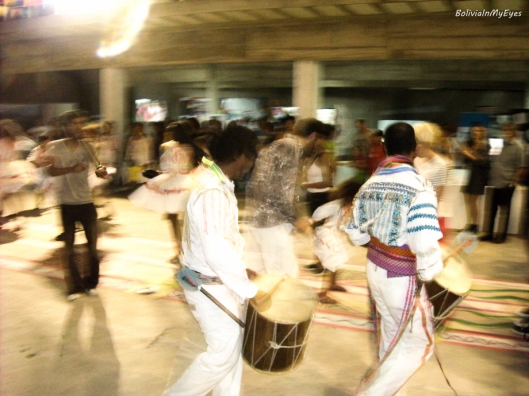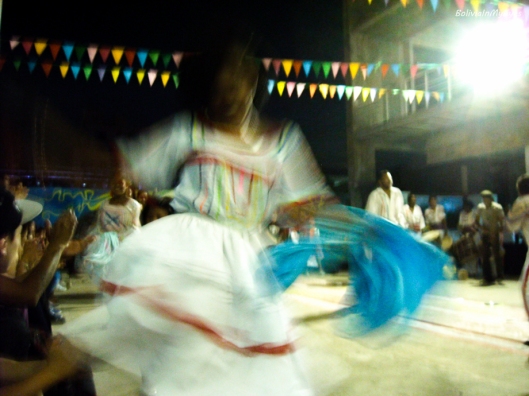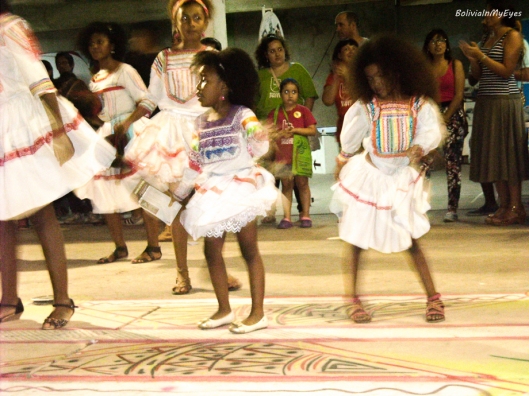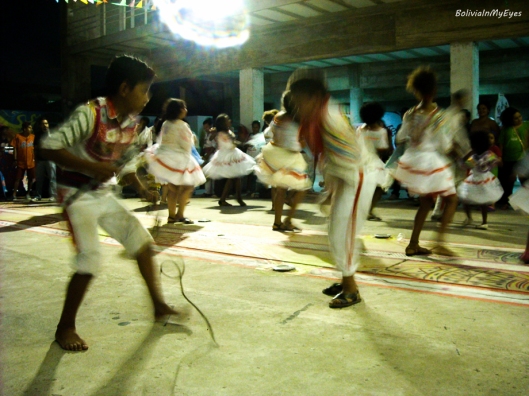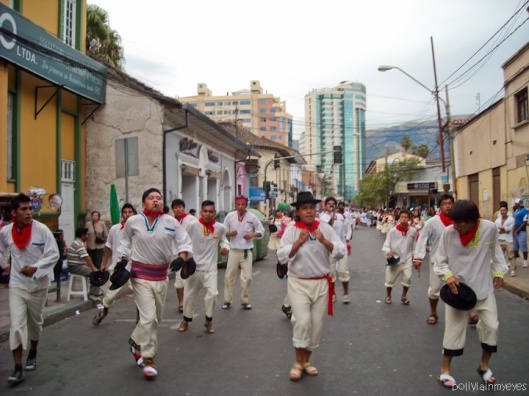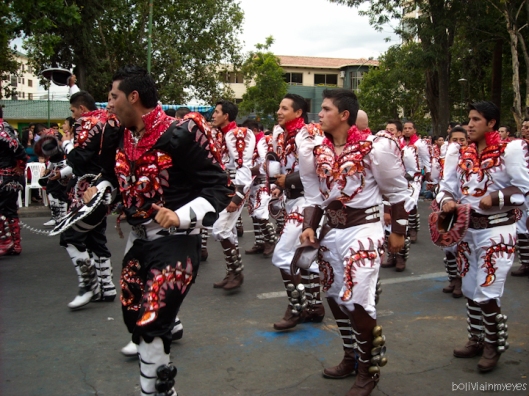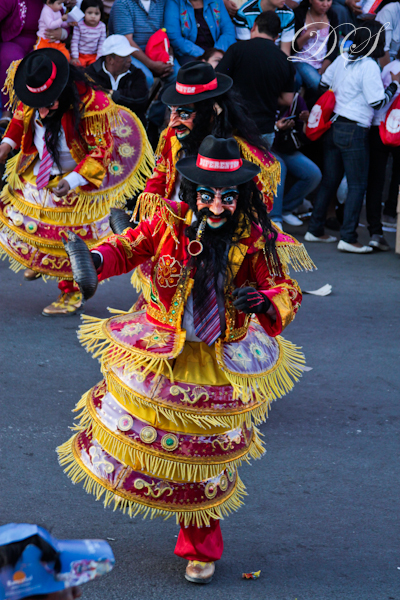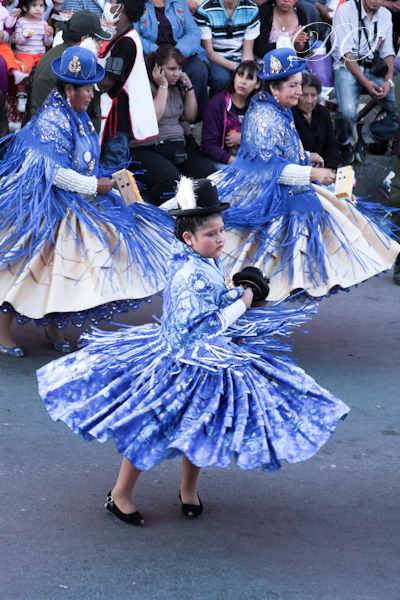Afro – boliwijska Saya jest rytmem muzycznym i tancem wywodzacym sie z tropikalnego regionu La Paz, Las Yungas, dokad od XVI wieku konkwiskadorzy sprowadzali niewolnikow z Afryki, wykorzystujac ich jako tania sile robocza na plantacjach.
Nazwa Saya wywodzi sie prawdopodobnie od slowa ‘nsaja‘, w jezyku kikongo (Kongo) oznaczajacego wspolna prace wykonywana przy akompaniamencie spiewnego glosu lub piesn pracujacych. W jezyku quechua Saya oznacza zas ‘tego, ktory zawsze stoi’.
Przez wieki, kultura afrykanska wymieszala sie z rodzima tradycja andyjska, stajac sie waznym elementem kulturowym Wielonarodowej Boliwii (Estado Pluronacional). Dzis mozna uslyszec i zobaczyc Saye nie tylko w tropikalnych Yungach. Taniec ten obecny jest podczas kazdej uroczystosci religijnej, kazdego karnawalu (—>Entrada Universitaria Folklorica/ Fiesta de Virgen de Urkupiña/ Carnaval en Cochabamba).
. Wykonywany jest on glownie przez studentow uniwersytetow, ktore odgrywaja wielka role w konserwacji i szerzeniu tradycji narodowych.
My ostatnio mielismy okazje podziwiac Saye w Centro de la Cultura Pluronacional Santa Cruz, w wykonaniu lokalnej spolecznosci afro-boliwijskiej. Hipnotyzujace dzwieki bebnow polaczone z rytmicznym spiewem i z widokiem krecacych sie spodnic, porwaly wszystkich zgromadzonych do tanca.
Ja osobiscie zostalam porwana przez tancerke, ktora pokazala mi kilka krokow. Niestety, jak sama przyznalam, brakowalo mi tej szerokiej pollery, nawiazujacej do spodnicy kobiet Aymara, ktora zatuszowalaby moje braki w kreceniu biodrami:)
Najwiecej oklaskow zebraly zas dzieci, ktore z zapalem wlaczyly sie w taniec. To na nich bedzie spoczywal obowiazek i zaszczyt w podtrzymywaniu tej jakze unikalnej tradycji.
Kultura afrykanska na stale zagoscila w tradycji muzycznej Boliwii, dajac poczatek chyba najbardziej popularnemu dzis tancu – Caporales, powstalym w latach 60-tych ubieglego wieku. Tak sie jednak sklada, ze meski stroj Caporales nawiazuje nie do jasnego, lekkiego i wygodnego ubioru tancerzy Saya, ale do munduru hiszpanskich straznikow (Caporal – kapral), nadzorujacych prace niewolnikow. Podobno, bracia Estrada Pacheco, ktorzy stworzyli nowy taniec, zaispirowali sie postacia, ktora w Saya tanczac z batem w reku, symbolizuje wlasnie zolnierza przywolujacego niewolnikow do porzadku.
Mezczyzni w Caporales maja odzwierciedlac idee silnego ‘macho’, podskakujac i wymachujac ramionami, podczas gdy kobiety koncentruja sie na kreceniu biodrami i pokazywaniu nog. (Interesujace jest jednak to, ze i kobiety moga tanczyc meska partie taneczna).
Stylistycznie jak i ideologicznie, Caporales daleki jest wiec od oryginalnej Saya, stajac sie niemal synonimem popularnej kultury latynoamerykanskiej.
Saya afro-boliwijska zostala rozprepagowana przez zespol Los Kjarkas, ktory w wielu swoich znanych przebojach wykorzystuje rytmy bebnow rodem z ‘czarnego ladu’, jednoczesnie laczac je z Caporales i innymi tradycyjnymi melodiami boliwijskiego Altiplano, wygrywanymi na malej gitarze charango i fletni Pana (zampoña).
Moja ulubiona piosenka Saya z repertuaru tego zespolu jest ‘El ritmo negro Caporal’. Posluchajcie:
P.S. Innym boliwijskim tancem charakteryzujacym sie mieszanina elementow rdzennych i afrykanskich jest Morenada —> 100% Boliviana.
Zrodla: Wikipedia, danzasdebolivia.wordpress.com, flordelapacho.com i doswiadczenie wlasne.
***
Afro – Bolivian Saya is the musical rhythm and dance originating in the tropical region of La Paz, Las Yungas, where from the sixteenth century onwards slaves had been brought from Africa by conquistadors, to be used as a cheap workforce on plantations.
Saya’s name derives probably from the word ‘nsaja‘, that in the language of Kikongo (Congo), means ‘work performed to the accompaniment of melodious voice’ or work song. In the Quechua language, Saya means ‘the one that always stands on his feet’.
For centuries, African culture have mixed with the native Bolivian Andean tradition, becoming an important cultural element of the todays’ Multinational Bolivia (Estado Pluronacional). And today you can hear and see Saya not only in tropical Yungas. This dance is also present during every religious ceremony, every carnival (—>Entrada Universitaria Folklorica/ Fiesta de Virgen de Urkupiña/ Carnaval en Cochabamba). It is danced mainly by students of the universities that play big role in the conservation of national traditions.
Recently, we had a chance to admire Saya in the Centro de la Cultura Pluronacional Santa Cruz, performed by local Afro-Bolivian community. Mesmerizing sounds of drums combined with the views of twirling skirts, made everybody dancing. I personally joined dancers who showed me few steps. Unfortunately, as I admitted, I missed the wide pollera, referring to the skirt of Aymara women, which would help to hide my akward hips moves :)
The children, who eagerly joined in with the dancers, gathered the most applouse. They are the ones who will have to preserve this unique tradition for future generations.
The African culture established its presence in the musical tradition of Bolivia, by becaming the basis for perhaps the most popular Bolivian dance – Caporales. However, the male outfit of Caporales isn’t light and comfortable like the clothing of Saya dancers, but looks like the uniform of Spanish guards (Caporal – Corporal) who were supervising the work of slaves. Apparently, Estrada Pacheco brothers who created this new dance in the 60’s, were inspired by a character in Saya, who dancing with a whip in his hand, symbolizes the soldier invigilating the slaves.
Males dancers in Caporales reflect the idea of a strong ‘macho’, jumping and waving their arms, women however are concentrated on moving their hips and chest, and showing off their legs. (Interestingly, women can also dance the male parts!).
Stylistically and ideologically, Caporales is very far from the original Saya, becoming almost a synonymous of a Latin American popular culture.
Afro-Bolivian Saya was popularized by the band Los Kjarkas, that uses the rhythms of drums straight from the ‘black land’ in many of their hits, at the same time combining them with Caporales and other traditional melodies of Bolivian Altiplano, played on charango (small guitar) and zampoña (pan flute).
My favorite Saya song from the repertoire of the band is ‘El ritmo negro Caporal’ (to watch the video, scroll up to Polish version).
P. S. Another Bolivian dance characterized by a mixture of indigenous and African elements is Morenada —> 100% Boliviana.
Sources: Wikipedia, danzasdebolivia.wordpress.com, flordelapacho.com and my own experience.
